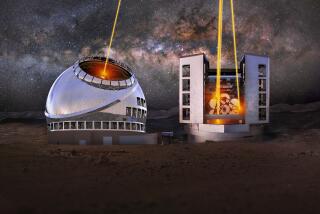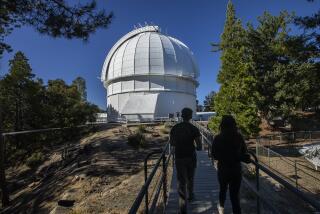Maarten Schmidt dies; Caltech astronomer changed our understanding of the cosmos

- Share via
Maarten Schmidt, the Dutch-born American astronomer whose discovery of quasars dramatically changed our understanding of the evolution of the cosmos and revealed the power and potency of the beasts that roam deep space, has died at his home in Fresno.
A professor emeritus at Caltech, Schmidt died Saturday at 92.
Schmidt had only recently arrived at Caltech when he ascended in the observing cage of the great Palomar Mountain telescope to try to understand measurements radio astronomers were getting from a bizarre object that should have been a star but couldn’t possibly be.
The object, known as 3C273 in the flavorless argot of astronomy, was 3 billion light years away, a good chunk of the way back to the Big Bang. Yet it was hundreds of times brighter than our own galaxy of 100 billion stars. Even more curiously, when Schmidt finally got a spectrum of its light signature, it looked like nothing he had seen before.
After weeks of futile puzzling, Schmidt told his wife, Corrie, “Something terrible happened at the office.”
It turned out not to be so terrible, after all. Maarten Schmidt had discovered the quasar (quasi-stellar radio source), an engine of unbelievable power. So unbelievable it was another six years before Donald Lynden-Bell, one of Schmidt’s students, came up with the explanation: a hungry black hole consuming a meal. Nothing can escape the fearsome gravitational power of a black hole, but material at the edge of its churning whirlpool is so super-heated that bursts of energy are shot out at nearly the speed of light.
This energy blast was what radio telescopes on Earth were picking up. It wasn’t a galaxy, and it wasn’t a star, or even a black hole, exactly. It was the radiation spun off by the greatest show in the universe.
The discovery made Schmidt famous. His angular, bespectacled countenance appeared on the cover of Time magazine. Awards flowed his way. And unlike some discoveries of oddities in space, the importance of Schmidt’s work only grew with time, as cosmologists realized the role quasars played in building the modern universe.
“The discovery of quasars is one of the fundamental discoveries of astrophysics, and it completely changed astronomy,” said George Djorgovski, astronomy professor and director of the Center for Data Driven Discovery at Caltech. Black holes had been a theoretical concept for some time, but quasars proved their existence in a concrete way. They would play a role in everything from proving the existence of dark matter to galaxy formation.
In 2008, more than four decades after his discovery, Schmidt and Lynden-Bell received the $1-million Kavli Astrophysics Prize for their work that “dramatically expanded the scale of the observable universe and led to our present view of the violent universe in which massive black holes play a key role.”
The son of a government accountant, Schmidt was born in Groninge, the Netherlands, on Dec. 28, 1929. At 12, he built his first telescope, using a lens he found at his grandfather’s farm. He was still a student at Groningen University when he attracted the notice of the country’s leading astronomer, Jan Oort, who gave his name to the Oort Cloud of comets surrounding the solar system.
Oort put Schmidt to work at the Leiden University observatory, the world’s oldest, measuring the brightness of comets. But it was his other early work, studying the spectroscopic fingerprint of hydrogen, that would prove crucial a decade later, when he discovered an object that made a supernova look like a child’s cap gun.
Schmidt’s reputation for exacting doggedness eventually brought him to the attention of the astronomers at the Mt. Wilson and Palomar observatories in Southern California. At the time, those observatories boasted the world’s greatest assemblage of star surveyors, from Walter Baade, who doubled the known size of the universe, to Fritz Zwicky, who predicted the existence of dark matter.
By the time Schmidt joined them in 1959, an important instrument was revolutionizing astronomy, the radio telescope. For millennia, visible light was the only medium people used to understand what was going on beyond Earth. But electromagnetic waves come in all sizes, from the shortest wavelengths, and the highest frequencies — powerful gamma rays and X-rays — through ultraviolet, visible, infrared, microwaves and, finally, low-frequency radio waves.
Radio waves are much longer than light waves, ranging from centimeters to kilometers, which is why radio telescopes have to be very large. That can be a problem, but a radio telescope has key advantages, including the ability to see through interstellar dust that would block radiation with shorter wavelengths. That meant radio telescopes could plumb extremely distant regions of the universe.
By 1961, Schmidt finally got his chance to operate the big, 200-inch telescope at Palomar, an instrument so grand that the greatest astronomers waited months and years for an opportunity to use it. Schmidt’s job was to track down some strange objects that were being uncovered by radio telescopes. It was time-consuming, tedious work, but one for which the patient young astronomer was ideally suited.
“It was romantic!” he told an interviewer later. “Once in a while you just had to stop and look around you.”
Most of the radio sources turned out to be ordinary elliptical galaxies. But a few were puzzling. They didn’t look at all like galaxies. Instead, they looked very much like stars. Very powerful stars. He was particularly interested in 3C273, which radio astronomers in Australia had narrowed down enough to a region of sky that Schmidt thought he had a chance to capture at Palomar. In late December, 1962, just weeks after the Cuban Missile Crisis brought the world to the edge of nuclear annihilation, Schmidt finally nailed it. But that didn’t solve the mystery. In fact, it was just beginning.
The mysterious 3C273 turned out to be two sources, a star and an attached jet of gaseous material. The spectra he got on his photographic plates made no sense. The emission lines on the spectrogram didn’t match anything he knew.
A few weeks later, Schmidt was sitting in his office on the second floor of the Robinson building at Caltech, when something clicked. The image, he suddenly realized, looked a lot like the fingerprint of hydrogen, the primary fuel of stars. Only it was redshifted tremendously, meaning the object was traveling away from Earth at a fantastic speed, almost 30,000 miles a second, and was fantastically far away.
Yet it was brighter than most closer galaxies. If it was that far away, how could it even be seen? It shined with the light of 2 trillion stars, yet it was only about the size of our solar system, less than a light year, while the Milky Way is 100,000 light years in diameter. What was going on?
Schmidt was still unsure whether he was looking at something much closer, in our own galaxy, and therefore much less interesting, when he went to a colleague puzzling over a similar object. It had the same telltale signature, and was even more redshifted, meaning it was even farther away. That was the aha moment.
In March, 1964, Schmidt became an instant scientific celebrity when he and his colleagues published four now classic papers describing what Schmidt called quasi-stellar radio sources. It took some time before the scientific community accepted the term quasars.
In an interview in 2014, Schmidt recalled the excitement around his discovery. It was all very flattering and, not insignificantly, good for his career. He became chairman of the Division of Physics, Mathematics and Astronomy at Caltech in 1975, and then director of the Hale Observatories, which operated the Palomar and Mt. Wilson instruments.
“It was a fantastic event,” Schmidt said. “But once it’s done, it’s done.”
The more satisfying work came later, when he was able to show where quasars fit on the timeline of the universe. As some of the most distant objects that can be studied, which also makes them the oldest, “they show a snapshot of what the universe was like at that time,” he said. “I was able to collect evidence about the early evolution of the universe.”
According to Djorgovski, they provided the first indications for what is known as the reionization epoch of the early universe, when stars and galaxies first began to form. “That was one of the major steps in the evolution of the universe,” Djorgovski added.
Quasars turned out to be cosmic dinosaurs, ancient beasts roaming the landscape of space and preying on weaker creatures to feed their enormous appetites. This, along with the discovery of the cosmic microwave background, proved to be the final nail in the coffin for the so-called steady state theory of the universe, which maintained that the universe had always been like this, and always would be.
These relics of an ancient cosmos, so fantastically far off and so different from anything being created in space today, was proof that the young universe was a far different place.
It is now believed that there are supermassive black holes at the center of most large galaxies, like the Milky Way. But relatively few, these days, have quasars, or what are now called active galactic nuclei. They are active because they are eating. Over time, the vast majority of black holes consume all the dust and gas and other things in their region and go into hibernation.
The black hole at the center of the Milky Way, known as Sagittarius A*, is one of these. In the future, however, its appetite will awaken. The closest big galaxy, Andromeda, is steadily approaching the exurbs of the Milky Way. The two giants will collide in about 4 billion years.
That event will send tides of gas and dust washing up against the lethal shoreline of the black holes in both galaxies. It should be a fantastic show, but no one on Earth will see it. By that time, the sun will have bloated and reddened and made our planet uninhabitable.
Following his brush with fame, Schmidt served two years as president of the prestigious American Astronomical Society. Along with the Kavli Prize, he won the Gold Medal of the Royal Astronomical Society in 1980 and the James Craig Watson Medal in 1991.
Schmidt was married to Cornelia “Corrie” Schmidt-Tom for 64 years, until her death in 2020. He is survived by his three daughters, Anne, Marijke, and Elizabeth.
Johnson is a former Times staff writer.
More to Read
Start your day right
Sign up for Essential California for the L.A. Times biggest news, features and recommendations in your inbox six days a week.
You may occasionally receive promotional content from the Los Angeles Times.






